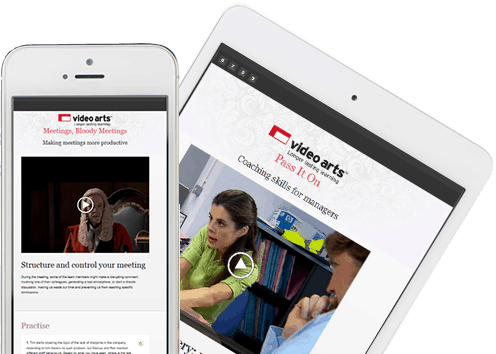While this was fine in principle, many organisations that implemented digital learning struggled to overcome the challenges of dull courseware and learner indifference. In fact, it took some considerable time for digital learning to start to achieve its potential.
Forgive me for quoting Abba but ‘the history book on the shelf is always repeating itself’
Today’s mindset is: we have handheld devices; let’s use them for learning. Forgive me for quoting Abba but ‘the history book on the shelf is always repeating itself’. If m-learning can learn the lessons from e-learning, then far fewer fingers will get burned this time around.
With such a wide range of options for delivering learning already available, a valid question to ask is: do we really need another? The simple answer is yes, if we want our learning to have more impact. Utilising handheld devices to access and enhance video-rich learning is not only a logical progression; it’s an unstoppable force that stems from the coming together of seven trends:
1. The demand for just-in-time learning.
Learning departments have long been under pressure to deliver learning quickly and not to take people away from their desks. This has led to an increase in demand for micro-learning, just-in-time interventions that support individual learners. Rather than a whole training course, it might be that the individual just wants the convenience of learning (or refreshing their learning on) a specific, salient point.
2. The increased take-up of smartphones.
It already seems a long time ago since mobile phones were used mainly to make phone calls. The ubiquity of handheld devices presents people with the ability to consume interactive, media-rich content all day long: which, in turn, is a great opportunity to deliver performance support and learning content to employees whenever it is needed.
3. People like to learn via video.
Video has always been a popular and effective means of training. It stimulates, engages and entertains people, triggering them to think, feel and do things differently. It allows complex ideas, particularly ones around soft skills behaviour, to be put across in a short space of time. Commercial video libraries are now available which offer flexible online access to thousands of individual video clips, each of which last a few minutes and focuses on a particular topic, everything from customer service to leadership. These clips – which can include ‘wrong way-right way’ scenarios – make an ideal ‘learning grenade’ for demonstrating behaviours or reinforcing a key message.
4. The growth of online video.
Technological developments have changed the delivery of video in training, from 16mm reels, VHS, CD-Rom and DVD through to video streaming. With the likes of YouTube, BBC iPlayer, iTunes, LoveFilm and BT Vision, we’ve all become much more comfortable with watching video online.
5. The desire to ‘mash’ content into a custom experience.
It’s easier than ever to create your own content. However, it is not so easy to create context-specific learning. Content may be king but context is the kingdom and more and more organisations are now taking content from publishers and mashing it up with their own expertise and insights, or adding their own branding, to make their content more engaging and memorable.
6. The demand for exciting learning.
Learners have always cried out for humour and personality in training. However, the humour has to support the learning. You can’t just shoe-horn gags in, for the sake of it. The essential principle here is that people learn nothing when they’re asleep and very little when they’re bored. To learn, we have to be engaged. When learning is fun and interesting, we become emotionally involved. So, by stimulating and engaging people, humour can make learning much more memorable.
7. The availability of apps.
Apps are being developed across different platforms, to run on desktops, tablets and smartphones. They’re easy to create and intuitive to use, which makes them ideal for either just-in-time skills development or refresher training. As new roles or projects are assigned to employees, you can imagine video-rich apps providing targeted functionality on demand.
If past experience has taught us anything, it is that technology is merely an enabler in the learning process.
Learning the lessons
M-learning can be an effective way to provide supplementary hints and tips at the point of need. However, simply making m-learning available to unprepared and unsupported learners will not work. It must be appropriately presented and adequately resourced. This is one of the biggest lessons from e-learning.
If past experience has taught us anything, it is that technology is merely an enabler in the learning process. It can improve access and increase efficiency, speed and productivity in terms of the way information and opportunities for learning are delivered to the individual. But the real questions you should be asking are: What skills do people need to learn in the organisation? What are their preferences for learning? Why should they be willing to acquire the necessary skills and how can technology assist in that process?
We shouldn’t be reinventing the wheel when adopting m-learning. Using the lessons from e-learning, my advice is:
- Take a blended approach. E-learning has rarely been effective as a standalone form of training. M-learning is likely to be no different. Organisational learning strategies should aim to link m-learning with instructor-led courses, performance support tools or self study tools to ensure a holistic approach.
- Keep your content relevant. As with e-learning, people are more likely to use m-learning if it relates to the challenges and issues that matter in the organisation. If it doesn’t, they’ll find all sorts of excuses and arguments not to use it.
- Make it engaging. You may be able to present content in a way that is easy to access but people will only learn if they’re motivated. Effective learning demands engagement. M-learning developers should bear in mind that e-learning really began to gain a foothold when it started to incorporate video.
- If you’re incorporating video, frame it. Like paintings, video clips need a ‘frame’. Always set your video in context, so learners know what they are watching and why – and what they’re meant to do as a result.
Recognise that a change of role is required. The L&D role is no longer to provide learning at specific times. Instead, it is to help individuals to make the best of the learning that’s available to them and to access it on-demand.
If you ignore these lessons, and the basic questions about learning and its role in the organization, you’re likely to encounter disappointment and frustration. M-learning is already happening and its evolution is inevitable. You may be able to resist the pull of technology but can you really resist the pull of learner expectations? Quite simply, this is what people want. Will your organisation be able to deliver it?



